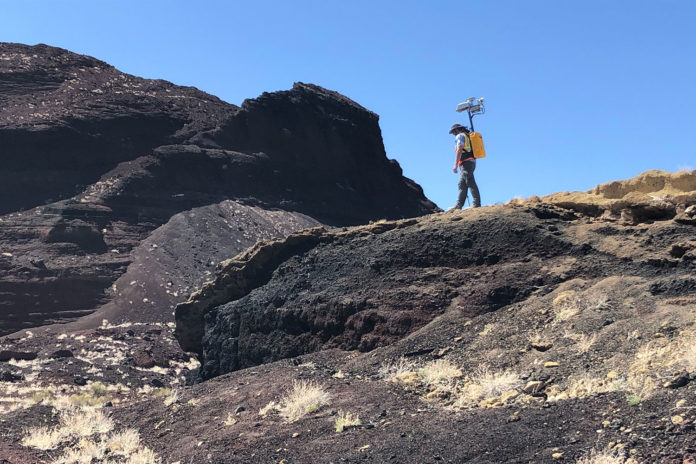As NASA wants to return humans to the Moon under the Artemis program, there are a lot of infrastructures that need to be built to make sure astronauts are safe and productive on the lunar surface. Exploring unmapped territory on the Moon is a lot harder.
NASA researchers and their industry partners have developed a remote-sensing mapping system set to aid explorers in the most isolated wilderness imaginable – the airless wastes at the South Pole of the Moon. Called the Kinematic Navigation and Cartography Knapsack (KNaCK), the system is a mobile lidar scanner – a remote sensing method that uses light detection and ranging laser light to measure range.
Donned like a hiker’s backpack, it uses a frequency modulated continuous wave (FMCW) lidar to provide Doppler velocity and range for millions of measurement points per second. These measurement points instantly create a real-time navigation system, delivering to the explorer a 3D “point cloud” or high-resolution map of the surrounding terrain.
Planetary scientist Dr. Michael Zanetti, who leads the KNaCK project at NASA’s Marshall Space Flight Center in Huntsville, Alabama, described the “lunar backpack” as a superpowered version of laser range finders used by surveyors or the highly sensitive proximity alarms that help smart cars avoid collisions.
“Basically, the sensor is a surveying tool for both navigation and science mapping, able to create ultra-high-resolution 3D maps at centimeter-level precision and give them a rich scientific context,” Zanetti said. “It also will help ensure the safety of astronauts and rover vehicles in a GPS-denied environment such as the Moon, identifying actual distances to far-off landmarks and showing explorers in real-time how far they’ve come and how far is left to go to reach their destination.”
Using the KNaCK lunar backpack, explorers could precisely map the topography of the landscape, including deep ravines, mountains, and caves. The lidar even works in pitch blackness, relieving astronauts of the need to haul cumbersome lighting rigs everywhere they go.
The lunar backpack prototype weighs about 40 pounds (18 kg). Its high-resolution precision makes it a vital resource for conducting science and mission operations 238,900 miles away from mission control.
“As human beings, we tend to orient ourselves based on landmarks – a specific building, a grove of trees,” Zanetti said. “Those things don’t exist on the Moon. KNaCK will continuously enable explorers traversing the surface to determine their movement, direction, and orientation to distant peaks or to their base of operations. They can even mark specific sites where they found some unique mineral or rock formation, so others can easily return for further study.”
Next, the KNaCK team will work to miniaturize its hardware and harden the sensitive electronics against the punishing effects of microgravity and solar radiation. Researchers envision it to be small enough to mount on the side of an astronaut’s helmet – which should leave plenty of room in future lunar mountaineers’ all-purpose backpacks.
